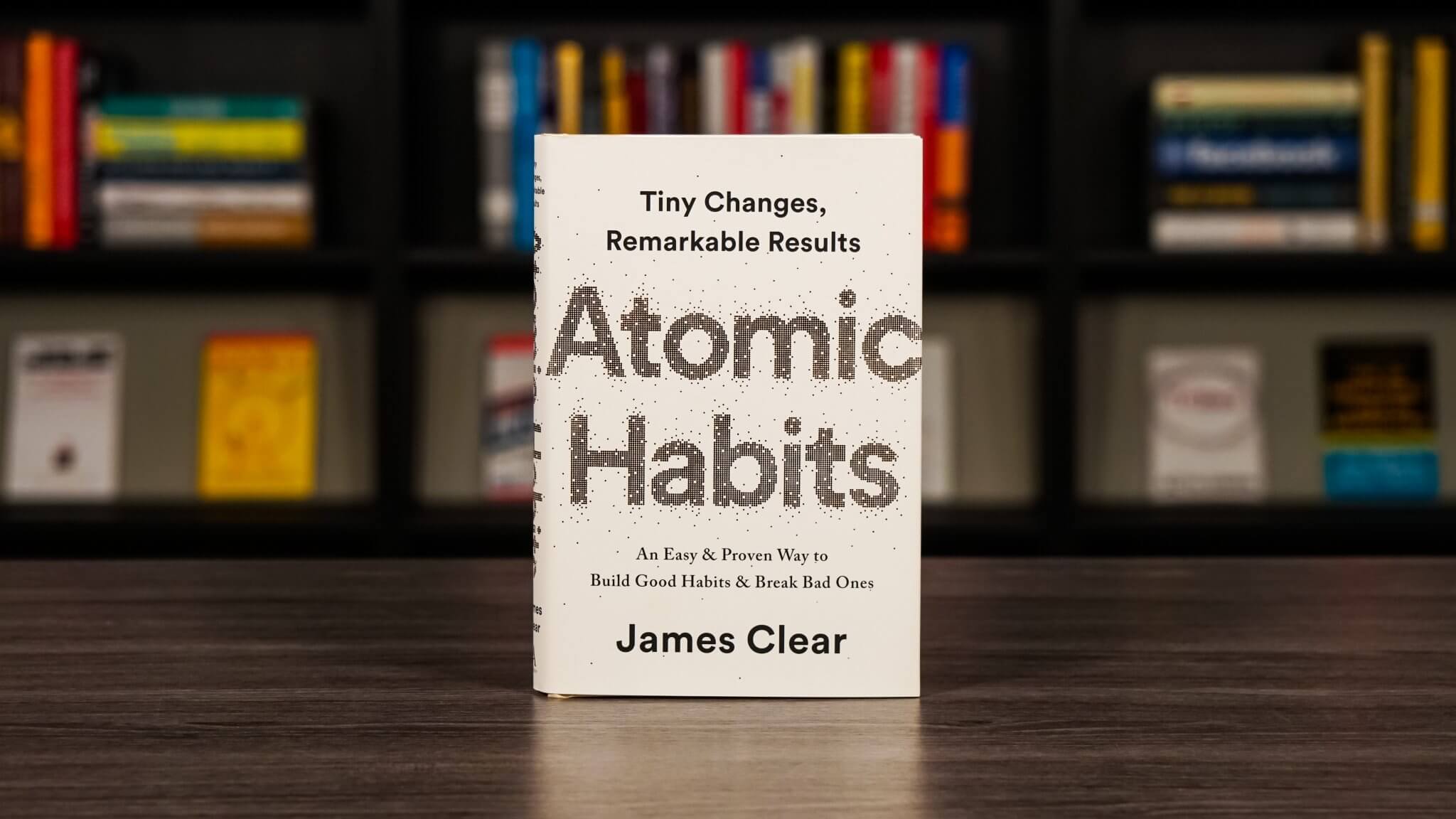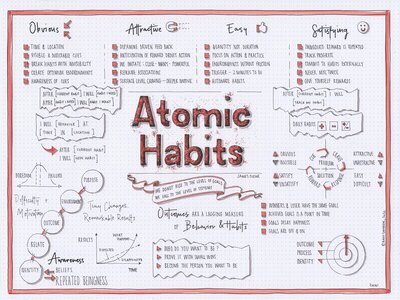Habits are an integral part of our lives, they shape our actions, thoughts, and ultimately our destiny. Habits are not formed overnight, they are a result of consistent actions that we perform repeatedly. The quality of our habits determines the quality of our lives. Good habits lead to success, happiness, and fulfillment, while bad habits lead to failure, misery, and regret. Therefore, it's essential to cultivate good habits that align with our goals, aspirations, and values.

James Clear's book "Atomic Habits" is a revolutionary guide that helps individuals create small habits that can lead to big changes in their lives. The book is based on the idea that small changes can create significant results if they are done consistently over time. The author presents a practical framework that can help anyone transform their habits and create a life of success, happiness, and fulfillment. In this blog, we will discuss some of the key concepts of the book and how they can be applied in real life.

The Four Laws of Behavior Change
The author presents four laws of behavior change that can help individuals create good habits and break bad ones. The four laws are:
- Make it obvious
- Make it attractive
- Make it easy
- Make it satisfying
Making it obviously means that individuals should make their habits visible and clear. They should create a visual cue that reminds them of their habits. For example, if someone wants to drink more water, they can place a water bottle on their desk or carry it with them wherever they go. This will remind them to drink more water throughout the day.
Making it attractive means that individuals should make their habits appealing and rewarding. They should associate their habits with something positive that they enjoy. For example, if someone wants to exercise more, they can listen to their favorite music while working out or reward themselves with a healthy snack after the workout.
:max_bytes(150000):strip_icc()/3145195-article-tips-to-reduce-stress-5a8c75818e1b6e0036533c47-922c3155e9c846eaa7447c75030b2c13.png)
Making it easy means that individuals should make their habits simple and effortless. They should break down their habits into small and manageable tasks. For example, if someone wants to read more books, they can start by reading one page a day and gradually increase it over time.
Making it satisfying means that individuals should make their habits fulfilling and enjoyable. They should feel good after completing their habits. For example, if someone wants to meditate more, they can focus on the benefits of meditation such as reducing stress and increasing focus. This will make them feel satisfied and motivated to continue their habit.
The Four Laws of Behavior Change is a powerful framework that can help individuals create good habits and break bad ones. By following these laws, individuals can make their habits visible, appealing, simple, and fulfilling. This will make it easier for them to stick to their habits and create lasting changes in their lives.
The Power of Small Habits
The author emphasizes the power of small habits and how they can lead to significant changes in our lives. He argues that small habits are more sustainable than big ones because they are easier to maintain and require less willpower. Small habits can also create momentum that can lead to bigger changes over time. For example, if someone wants to lose weight, they can start by cutting out one unhealthy food item from their diet and gradually increase it over time. This will create a small habit that can lead to significant weight loss over time.

The author also emphasizes the importance of focusing on the process rather than the outcome. He argues that individuals should focus on the daily actions that lead to their desired outcomes rather than the outcomes themselves. By focusing on the process, individuals can enjoy the journey and create sustainable changes in their lives.
Conclusion
In conclusion, James Clear's book "Atomic Habits" is a powerful guide that can help individuals create small habits that lead to significant changes in their lives. The four laws of behavior change, the power of small habits, the 1% rule, and the importance of identity are some of the key concepts discussed in the book. By following these concepts, individuals can create sustainable habits that align with their goals, aspirations, and values. Habits are not formed overnight, they require consistent actions and effort over time. However, by focusing on small habits and making them a part of our identity, we can create lasting changes in our lives and achieve success, happiness, and fulfillment.
Want to buy a sleek, stylish, business style yet Gaming Oriented Laptop?
Well your search comes to an end now, HP has Launched its Ryzen series, and Not Gonna Lie HP is the most durable, reliable brand in the market.
I personally am using HP laptops for the past 10 years and not a single complaint whether about the software or the hardware.
The laptop which we are going to discuss today is HP 14s-fr0012AU. I will list down all the features, pros, and cons of buying a Ryzen laptop vs an intel laptop, and also last but not least: A Video Review.
Image Courtesy: Amazon
Processor: AMD Ryzen 5 3450U (2.1 GHz base clock, up to 3.5 GHz max boost clock, 4 MB L3 cache, 4 cores)
Operating System: Pre-loaded Windows 10 Home Single Language | Pre-Loaded Microsoft Office 2019
Display: 14 -inch FHD, IPS, micro-edge, brightview | Brightness: 250 nits | Screen Resolution: 1920 x 1080
Memory & Storage: 8 GB DDR4-2400 SDRAM (1 x 8 GB) & Expandable Up to 16 GB | Storage: 512GB PCIe NVMe SSD
Design & battery: Laptop weight: 1.46 kg | Battery life mixed usage = Up to 7 hours and 30 minutes | In the Box: Laptop, Battery, User Manual, and charger
Graphics: AMD Radeon Vega 8 Graphics
Camera & Microphone: HP True Vision 720p HD camera with integrated dual array digital microphones
Ports: 1 SuperSpeed USB Type-C (5Gbps), 2 SuperSpeed USB Type-A (5Gbps), 1 HDMI 1.4b, 1 RJ-45
One more excellent feature is that
You can upgrade it to Windows 11 and that too for FREE FREE FREE.
Now comes the Price :
You can tame this beast at just ₹42,990 INR

That's what we thought Jimmy, But it is real.
No need to mention but will do it any way you can get additional discounts by cashing in the Independence Day Sale.
Now the part for which you have clicked this link
Unboxing and Review

The key to a successful fitness journey lies in a combination of both exercise and nutrition. While it's important to put in the effort at the gym, it's equally important to fuel your body with the right nutrients to support your fitness goals. In this blog post, we will be discussing a 7-day gym diet plan that will help you stay on track with your fitness goals.

Day 1:
On the first day of your gym diet plan, it's important to start your day with a healthy breakfast that will provide you with the energy you need for your workout. A good option is an oatmeal with some fresh fruit and a scoop of protein powder. For lunch, try a salad with some grilled chicken or fish and some healthy fats like avocado or nuts. For dinner, aim for a protein-rich meal like grilled chicken or salmon with some steamed vegetables.
Day 2:
For day 2 of your gym diet plan, start your day with a protein-packed breakfast like scrambled eggs with spinach and some whole-grain toast. For lunch, opt for a turkey or chicken sandwich on whole-grain bread with some veggies on the side. For dinner, try a stir-fry with some lean protein like shrimp or tofu, lots of veggies, and some brown rice.
Day 3:
On day 3, start your day with a protein shake made with protein powder, almond milk, and some frozen berries. For lunch, try a wrap with some grilled chicken or turkey, lots of veggies, and some hummus for added flavor. For dinner, aim for a protein-rich meal like grilled steak or pork chops with some roasted sweet potatoes and steamed veggies.
Day 4:
For day 4, start your day with some Greek yogurt topped with some fresh fruit and granola. For lunch, try a veggie burger on a whole-grain bun with some sweet potato fries on the side. For dinner, opt for a healthy pasta dish like whole-grain pasta with some grilled chicken, lots of veggies, and a tomato-based sauce.
Day 5:
On day 5, start your day with a breakfast burrito made with scrambled eggs, black beans, veggies, and some whole-grain tortillas. For lunch, try a spinach and quinoa salad with some grilled chicken or tofu and some nuts for added crunch. For dinner, try a grilled fish like salmon with some roasted veggies and quinoa on the side.
Day 6:
For day 6, start your day with a smoothie made with protein powder, almond milk, and some frozen fruit. For lunch, try a chicken or turkey wrap with some veggies and avocado on a whole-grain wrap. For dinner, try a lean protein like grilled chicken or fish with some roasted veggies and brown rice.
Day 7:
On the final day of your gym diet plan, start your day with a protein-packed breakfast like a spinach and feta omelet with some whole-grain toast on the side. For lunch, try a tuna salad on a bed of greens with some whole-grain crackers on the side. For dinner, aim for a lean protein like grilled shrimp or chicken with some roasted veggies and sweet potato on the side.

Conclusion:
By following this 7-day gym diet plan, you will be able to fuel your body with the right nutrients to support your fitness goals. Remember to also stay hydrated by drinking plenty of water throughout the day and snacking on healthy options like fruits, nuts, and veggies. With a combination of exercise and nutrition, you will be well on your way to achieving your fitness goals.


Banner ads have been a staple of digital advertising for many years, but with the ever-increasing amount of online competition, it can be tough to make your banner ads stand out. A banner ad's design plays a critical role in grabbing a viewer's attention and motivating them to click on the ad. In this blog post, we'll discuss how to create banner ads with effective design to boost clicks.
Table of Contents
- Use Eye-catching Colors
- Keep It Simple
- Add Clear Call-to-Actions
- Choose the Right Font
- Make Sure the Banner Ad is Mobile-Friendly
- Test and Optimize

Use Eye-catching Colors
One of the most critical elements of banner ad design is choosing the right colors. Bright and contrasting colors tend to catch viewers' attention, making them more likely to notice the ad. For example, if the banner ad is on a website with a white background, using a bright red or blue background can make it stand out. However, it's essential to use colors that match your brand and the message you're trying to convey.
Keep It Simple
When it comes to banner ad design, less is more. Keep your design simple, with a clear focus on the message you want to convey. Avoid using too many images or text, which can be overwhelming for viewers. A simple and straightforward design can make it easier for viewers to understand the ad's message and make them more likely to click on it.
Add Clear Call-to-Actions
A clear and concise call-to-action (CTA) is essential in banner ad design. The CTA is the button or link that viewers click on to take the desired action, such as making a purchase or signing up for a newsletter. Make sure the CTA is prominently displayed, and the text is easy to read. Using action-oriented language like "Buy Now" or "Sign Up Today" can motivate viewers to take action.
Choose the Right Font
The font you use in your banner ad design can significantly impact its effectiveness. Choosing a font that's easy to read is crucial, as viewers may not click on an ad they can't read. Sans-serif fonts like Arial or Helvetica are popular choices for banner ad design, as they're easy to read and look good on all devices.
Make Sure the Banner Ad is Mobile-Friendly
With the increasing amount of mobile traffic, it's crucial to design banner ads that are mobile-friendly. Make sure the ad's size and layout are optimized for mobile devices, with clear and easy-to-read text and images. Mobile users tend to have a shorter attention span, so make sure the ad's message is clear and concise.
Test and Optimize
Testing and optimizing your banner ad design is crucial to improving its effectiveness. A/B testing is a popular method to test different designs to see which one performs better. Try different colors, fonts, and CTAs to see which one generates the most clicks. Keep testing and optimizing your banner ad design to ensure its maximum effectiveness.

Conclusion
Effective banner ad design is essential to boost clicks and drive traffic to your website. By using eye-catching colors, keeping it simple, adding clear CTAs, choosing the right font, making it mobile-friendly, and testing and optimizing, you can create banner ads that stand out from the competition. Remember to keep your design consistent with your brand and message, and always strive to improve and optimize your design for maximum effectiveness.

Are you struggling to come up with the perfect gift for your special someone? It can be a challenge to find something that truly captures your feelings and shows them how much you care. But don't worry, we've got you covered! In this blog, we'll explore some gift ideas that are sure to make your special someone feel loved and appreciated.
1 . Personalized Gifts
One of the best ways to show your love and appreciation is to give a personalized gift. This shows that you took the time and effort to create something unique just for them. There are countless options when it comes to personalized gifts, such as customized jewelry, photo albums, or even a monogrammed bathrobe. The possibilities are endless, and you can tailor the gift to your special someone's interests and preferences.
2. Romantic Getaway
Another great gift idea is to plan a romantic getaway for the two of you. This could be a weekend trip to a nearby bed and breakfast or a full-blown vacation to a tropical paradise. The key is to choose a location that you both will enjoy and create memories that will last a lifetime. Make sure to plan out activities and experiences that cater to your special someone's interests and hobbies.
3. Spa Day
Sometimes the best gifts are the ones that allow your special someone to relax and unwind. A spa day is a perfect example of this type of gift. Treat them to a massage, facial, or other spa treatments that will help them de-stress and feel pampered. You could even make it a couple's spa day and enjoy the experience together.
4. Thoughtful Gestures
Not all gifts have to be grand gestures or expensive items. Sometimes it's the small things that mean the most. Consider doing something thoughtful for your special someone, like cooking their favorite meal or leaving little notes of appreciation around the house. These gestures show that you are thinking of them and caring about their happiness.
5. Tech Gadgets
If your special someone is a tech lover, consider getting them a new gadget or accessory. This could be anything from a new phone or tablet to a smartwatch or wireless headphones. The key is to choose a gift that they will actually use and appreciate. Do some research to find out what tech gadgets are currently trending and what features your special someone would find most useful.
6. Creative Experiences
Sometimes the best gifts are the ones that allow your special someone to explore their creative side. Consider signing them up for an art class or workshop, or buy them a DIY kit for a project they've been wanting to tackle. These gifts not only allow your special someone to learn and grow but also give them a sense of accomplishment and pride in their work.
7. Home Decor
If your special someone is a fan of interior design or loves to decorate their home, consider getting them a gift that caters to their interests. This could be anything from a new piece of artwork to a decorative vase or candle. You could even get them a subscription to a home decor magazine or website to help inspire their creativity.
8. Fashion Accessories
If your special someone loves fashion, consider getting them a new accessory to add to their collection. This could be anything from a designer handbag or shoes to a statement piece of jewelry. The key is to choose something that fits their style and personality.
9. Fitness Gear
For the fitness enthusiast in your life, consider getting them a new piece of workout gear or equipment. This could be anything from a new set of weights or yoga mats to a fitness tracker or smart water bottle. These gifts not only show that you support their healthy lifestyle but also help them reach their fitness goals.
10. Time Together
Sometimes the best gift of all is simply spending time together. Consider planning a day trip or weekend getaway to a place you both love or create a special date night at home with a homemade dinner and a movie. These gifts offer the opportunity to create memories and strengthen your bond.
In conclusion
when it comes to gift-giving for your special someone, the most important thing is to show your love and appreciation. Whether you choose a personalized gift or plan a romantic getaway, make sure it's something that caters to their interests and shows that you put thought and effort into the gift. Remember, it's not about the price tag but rather the sentiment behind the gift that truly matters.

Habits are an integral part of our lives, they shape our actions, thoughts, and ultimately our destiny. Habits are not formed overnight, they are a result of consistent actions that we perform repeatedly. The quality of our habits determines the quality of our lives. Good habits lead to success, happiness, and fulfillment, while bad habits lead to failure, misery, and regret. Therefore, it's essential to cultivate good habits that align with our goals, aspirations, and values.

James Clear's book "Atomic Habits" is a revolutionary guide that helps individuals create small habits that can lead to big changes in their lives. The book is based on the idea that small changes can create significant results if they are done consistently over time. The author presents a practical framework that can help anyone transform their habits and create a life of success, happiness, and fulfillment. In this blog, we will discuss some of the key concepts of the book and how they can be applied in real life.

The Four Laws of Behavior Change
The author presents four laws of behavior change that can help individuals create good habits and break bad ones. The four laws are:
- Make it obvious
- Make it attractive
- Make it easy
- Make it satisfying
Making it obviously means that individuals should make their habits visible and clear. They should create a visual cue that reminds them of their habits. For example, if someone wants to drink more water, they can place a water bottle on their desk or carry it with them wherever they go. This will remind them to drink more water throughout the day.
Making it attractive means that individuals should make their habits appealing and rewarding. They should associate their habits with something positive that they enjoy. For example, if someone wants to exercise more, they can listen to their favorite music while working out or reward themselves with a healthy snack after the workout.
:max_bytes(150000):strip_icc()/3145195-article-tips-to-reduce-stress-5a8c75818e1b6e0036533c47-922c3155e9c846eaa7447c75030b2c13.png)
Making it easy means that individuals should make their habits simple and effortless. They should break down their habits into small and manageable tasks. For example, if someone wants to read more books, they can start by reading one page a day and gradually increase it over time.
Making it satisfying means that individuals should make their habits fulfilling and enjoyable. They should feel good after completing their habits. For example, if someone wants to meditate more, they can focus on the benefits of meditation such as reducing stress and increasing focus. This will make them feel satisfied and motivated to continue their habit.
The Four Laws of Behavior Change is a powerful framework that can help individuals create good habits and break bad ones. By following these laws, individuals can make their habits visible, appealing, simple, and fulfilling. This will make it easier for them to stick to their habits and create lasting changes in their lives.
The Power of Small Habits
The author emphasizes the power of small habits and how they can lead to significant changes in our lives. He argues that small habits are more sustainable than big ones because they are easier to maintain and require less willpower. Small habits can also create momentum that can lead to bigger changes over time. For example, if someone wants to lose weight, they can start by cutting out one unhealthy food item from their diet and gradually increase it over time. This will create a small habit that can lead to significant weight loss over time.

The author also emphasizes the importance of focusing on the process rather than the outcome. He argues that individuals should focus on the daily actions that lead to their desired outcomes rather than the outcomes themselves. By focusing on the process, individuals can enjoy the journey and create sustainable changes in their lives.
Conclusion
In conclusion, James Clear's book "Atomic Habits" is a powerful guide that can help individuals create small habits that lead to significant changes in their lives. The four laws of behavior change, the power of small habits, the 1% rule, and the importance of identity are some of the key concepts discussed in the book. By following these concepts, individuals can create sustainable habits that align with their goals, aspirations, and values. Habits are not formed overnight, they require consistent actions and effort over time. However, by focusing on small habits and making them a part of our identity, we can create lasting changes in our lives and achieve success, happiness, and fulfillment.




